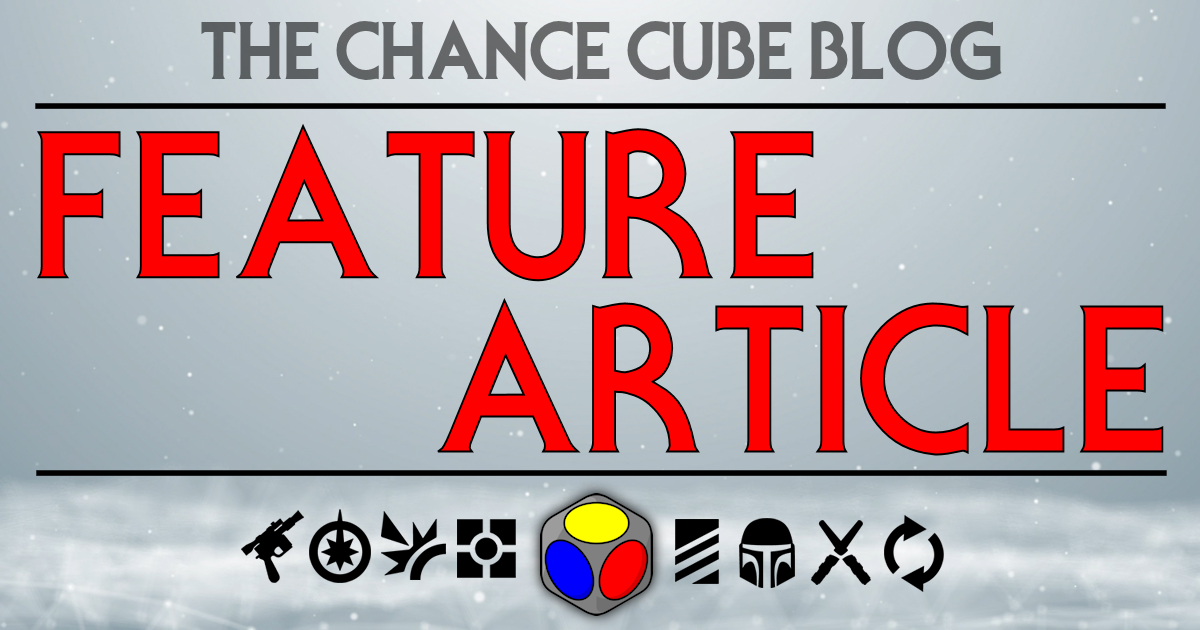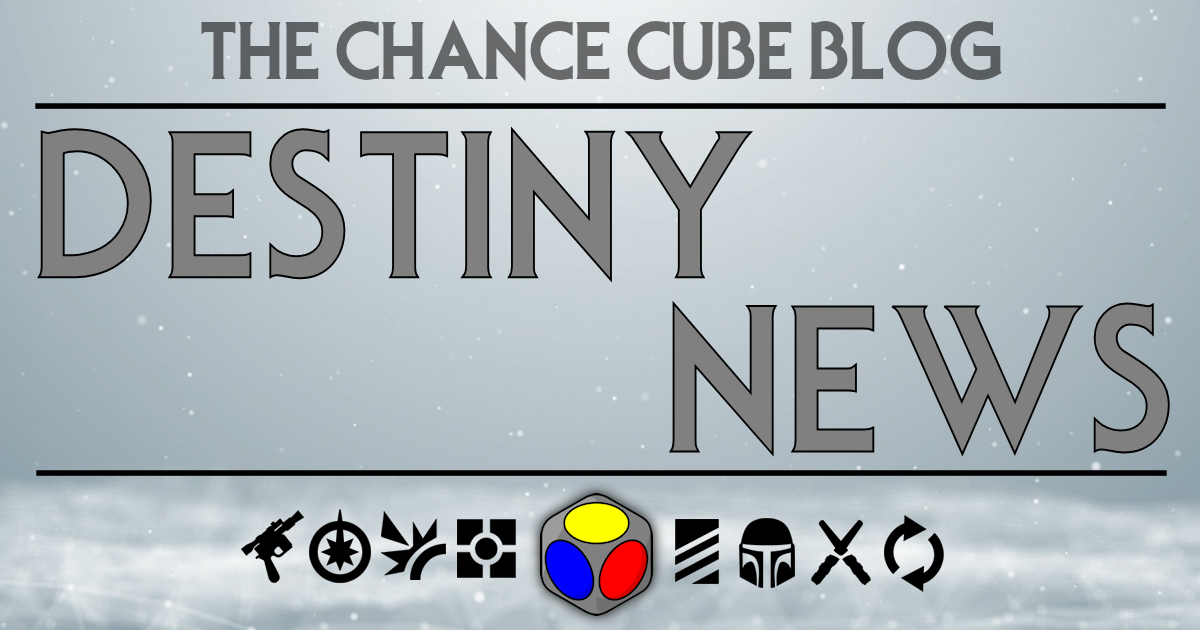Battlegrounds are quite possibly one of the most ignored part of deck construction. However, it can be one of the most important decisions as the battleground can both help you and hurt you at the same time. And not just by dealing damage. You need to give careful consideration to not only what battleground you take, or even if you want (or need) to take your battlefield if you win the initial dice roll. Continue reading “Beginners Guide to Destiny Part III: Battlegrounds”
Author: Matthew Budney
Your first Star Wars: Destiny Tournament
Fantasy Flight Games just released version 1.0 of their Star Wars: Destiny tournament rules. Game stores have, or will soon receive, any tournament kits that they have ordered from their distributor. So, many stores will start to be hosting tournaments soon. As such, for those players who are new to the tournament scene, or haven’t attended a tournament in some time, this article is for you. Continue reading “Your first Star Wars: Destiny Tournament”
Star Wars: Destiny Tournament Regulations
Fantasy Flight Games has a very well run Organized Play (OP) program for all of their competitive games. Along with the ladder tournament system (Relaxed, Store Championship, Regional, National, and Worlds), they provide excellent support for local run events, leagues, and other major conventions and events. As part of their effort to standardize their tournaments, they release official FAQ’s and tournament regulations, updating both as needed. Fantasy Flight Games just released version 1.0 of their Star Wars: Destiny Tournament Regulations. This is an overview of those regulations which go into effect January 1, 2017. Continue reading “Star Wars: Destiny Tournament Regulations”
Beginners Guide to Destiny Part II: Choosing your Characters
In my first article in this series, I talked about the two different ways to win, by milling their deck or defeating their Characters. In this article in the series I am going to talk about some basic tips and strategies when choosing your Characters, and some possible synergies that you can utilize. I will also expand on article I and include reasons to take specific Characters for a specific strategy. Continue reading “Beginners Guide to Destiny Part II: Choosing your Characters”
Beginners Guide to Destiny Part I: Choosing your Strategy
Star Wars: Destiny is a collectable card and dice game where two or more players battle each other with 30 card decks and 30 points worth of Characters. The only true limit on deck construction is the 30 card limit and that players cannot have more than 2 copies of any one card. As far as your Characters are concerned, you are limited by the fact that you cannot have more than 1 of the same unique Character (but can include 2 dice for that character), and a maximum of 30 points of Characters.
That is a lot of information to absorb, even for a game that was just recently released and has only 174 cards in the first set, Awakenings. But, it is very relevant and players need to understand what they are facing every time they play this game. Why? Because each player needs to know what the deck and character limitations are when they build their deck, as well as when deciding what strategies they want when designing their deck.
There are two ways to win a game of Star Wars: Destiny. Taken from page 14 in the Reference Guide: The first is to defeat all of your opponent’s Characters. The game ends immediately when that happens. The second is if your opponent has no cards in their hand and deck at the end of a round (after the upkeep phase). So, you could have no cards in your hand and deck and still be able to win if you deal enough damage to defeat your opponents Characters that round.
So, with that in mind, what Strategy should you use? Truthfully? The first thing you need to look at is your collection of cards, specifically your Characters and dice cards. You need to be able to field the cards that can allow you to accomplish your Strategy. There is no need of making a list with Han Solo (AW46) if you don’t own him, for example, or want to try a villain mill deck and not have any cards that support that strategy. I will go into much greater detail about choosing your Characters in part II of this series.
Some card combinations go hand in hand with your Strategy. For example, if you wish to work on a discard strategy, commonly called a mill deck, there is a good Character/Battleground combination that can be very deadly. Playing with Padme Amidala (AW48) who has a special dice ability that reads “Discard the top card of an opponent’s deck or spend 1 resource to discard the top 2 cards of an opponent’s deck.” This pairs well with the Command Center (AW165) battleground that has the claim of “Each opponent discards the top 2 cards of their deck.”
And, of course, the more damage sides on a die a character or upgrade has, the better they are in a damage dealing deck. For example, I would rather take Leia Organa (AW28) than Qui-Gon Jinn (AW37) in a straight up comparison of damage ability. And, while a Hired Gun (AW47) is nice and cheap at 8 points, having to spend 1 resource each time you wish to deal damage with that character die really puts a damper on your resources each turn.
In the end, there is no correct or incorrect Strategy. It is in the creation of a deck to execute that Strategy that player’s fall victim. Trying to run a damage deck with Jabba the Hutt (AW20) who has no native damage faces on his die forces you to play upgrades on him that allows the Character to deal damage, if that is your strategy.
Star Wars: Destiny Tabletop Simulator League Match Results (Part 1)
For those of you who do not know, the Star Wars: Destiny Tabletop Simulator League Season 1 started up, December 12th. This 8-week league pits players from all over the world against each other. Players are grouped into pods of 8, trying as much as possible to keep players in the same pod who can play at the same time. You play two games against each player in your pod, and results are recorded on the Challonge.com website. You are allowed to switch decks between games and opponents, and you don’t have to play both games against the same opponent at the same time. I was assigned to Group R. I will post how each of my matches go on The Chance Cube. Continue reading “Star Wars: Destiny Tabletop Simulator League Match Results (Part 1)”
Deckbuilding Thoughts: First Step into a Larger World
As a longtime fan of Fantasy Flight Games and a veteran of Decipher’s Star Wars and Star Trek CCG I am offering my thoughts and consideration when building a 30 card, 30 point Star Wars: Destiny deck. Due note that I am building this deck with the cards in my collection, and not a theory crafted “best” build. I am doing this because, as a collectable card and dice game, not everyone will have every card to make the best deck. I will, however, note cards that I wish to have replaced and what I want to replace them with.
My first step when building a deck is to decide what type of deck I want to make. Since there are two ways to win the game, by defeating your opponent’s characters or remove all their cards in their deck and hand, the deck I want to build needs to focus on doing one of those tasks. Do I want to play the long game and deal lots of damage slowly? Do I want to go for burst damage and be able to deal enough damage to defeat a character in a single action? Do I want to control your opponents dice and prevent them from controlling yours? A lot of it comes down to my creativity and the cards I own.
My characters for this deck are a two dice [infopopup tag=aw035] and a Hired Gun (AW47) for a total of 28 points. I chose to play these two characters because Luke is great for dealing large amounts of damage without needing to spend any resources to do so, and you draw a card when you activate him, so it gives you more options each turn. The Hired Gun in the deck also has good burst damage, and yes, you do have to pay for it. But, with a lucky roll you can deal 9 damage a turn without another die in play. That can take out a lot of health. Also, having access to both the blue and yellow cards allows me to have cards that go into my decks theme, which is high damage output. I could have chosen to take Padme Amidala (AW48), but she doesn’t deal damage by herself, and her ability doesn’t lend itself well to my deck idea.
Along with choosing starting characters, I need to pick a battleground. I picked Echo Base, Hoth (AW156). Its ability reads “Claim – Give a character 1 shield”. I love this ability. It doesn’t hurt me much if my opponent claims the battlefield, and it allows me to keep my two characters alive longer if I claim it. With only 2 characters and a total of 21 health between them, I need to do things that allow them to stay alive longer. When you can have 4 troopers for 28 health, or even 2 troopers and Kylo for a total 25, having 21 health is on the low side. Only the 2 dice Han/Rey combo has lower total health at 20.
My upgrades are as follows. I have two lightsabers. With three damage sides these are great for being able to help deal damage. And, it doesn’t matter if they go on Luke or the Hired Gun. Two Jedi Robes (AW40) are also in the deck. These are great turn 1 cards to play. Being able to add resources and focus your dice is nice, but they are in the deck primarily to add a shield, or two if it is the first turn of the game. Infiltrate (AW52) is a great yellow upgrade. Having a 1/3 chance of being able to force my opponent to reroll 2 of their dice without needing to spend a card is a great special ability.
I also have a single copy of both Cunning (AW65) and Force Protection (AW39). I decided to put only one of each because they are color character specific. They also have great abilities. Giving my character shields with Force Protection is great, and being able to use my opponent’s special abilities with Cunning is just nuts, and a good way to potentially be able to deal more damage. I round out my upgrades with a copy of the DL-44 (AW51) and [infopopup tag=aw044]. While decent cards by themselves, they are honestly placeholders until I can get my hands on two copies of the Holdout Blaster (AW63). Or, even a single Holdout Blaster and another Infiltrate. Yes, that brings my total to 9 dice upgrades. However, since Luke’s ability allows me to draw a card each time I activate him, this isn’t as much of a hindrance as you might think. Also, having only 2 characters to start with means that I am capped at having 6 upgrades in play at any one time.
To play with damage and hopefully keep my characters, especially Luke, alive longer, I am running with two copies of Willpower (AW122) to move 1 damage from my exhausted characters to my opponent’s. I also have two copies of Draw Attention (AW128) to move damage from Luke to the Hired Gun. These 4 cards can potentially remove 6 damage from Luke. Finally, a single copy of Second Chance (AW137) allows me to keep the Hired Gun in play longer than he normally would be.
For being able to mess with dice I have included two copies of Mind Trick (AW147), Daring Escape (AW126), Let the Wookiee Win (AW130), and Disturbance in the Force (AW146). I also have a single copy of Negotiate (AW131). Let the Wookiee Win is also a nice card as it can also be used to deal damage to a character if the dice my opponent has showing is too good to throw away. Mind Trick is fun mid to late game as it forces my opponent to make some difficult choices in what dice to put into what group, and Daring Escape is also nice when my opponent has several blank dice showing.
To round out supporting cards and being able to keep my characters alive longer I have two copies of [infopopup tag=aw157] which gives a single shield, and two copies of Defensive Stance (AW115), which gives two shields. These cards go great with my theme of using every trick I can to keep my characters alive as long as possible. I end my deck with two copies of Deflect (AW145) and a single Awakening (AW124). I choose Deflect to allow my opponents dice to hurt their own characters. Yes, there is a risk of my opponents not playing any cards that deal ranged damage, but for a single point, they are good to have. Awakening is a nice addition as there are some dice in my deck that do show a + symbol and being able to resolve them without assistance can be a great boon.
So, to sum up, I have built a deck to do the following with the cards I currently own: 1. Deal high burst damage. 2. Have cards that are able to manipulate my opponents dice into advantages for me. 3. Have cards that allow me to keep Luke and the Hired Gun alive longer than they normally would be.
So, what to do next? Get out and playtest. I have played several games already with this deck and I am pleased with the results. No, I don’t win every game. But, I do have a plan for each game I play. Once I get an upgrade or two on each of my characters, I can afford to spend a lot of resources on modifying dice and playing dirty tricks. Is this a perfect deck? No. Meta defining? No. Fun to play and something I am happy to play? Yes. And, in the end it will accomplish what I want it to do, and set out to do. Which is all I can ever ask for.


